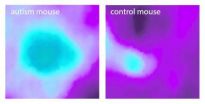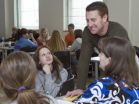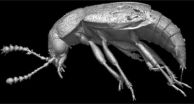(Press-News.org) This news release is available in German.
The insular cortex is an integral "hub", combining sensory, emotional and cognitive content. Not surprisingly, alterations in insular structure and function have been reported in many psychiatric disorders, such as anxiety disorders, depression, addiction and autism spectrum disorders (ASD). Scientists from Harvard University and the Max-Planck Institute of Neurobiology in Martinsried now describe consistent alterations in integrative processing of the insular cortex across autism mouse models of diverse etiologies. In particular, the delicate balance between excitation and inhibition in the autistic brains was disturbed, but could be pharmacologically re-adjusted. The results could help the development of novel diagnostic and therapeutic strategies.
Autism is a neurodevelopmental disorder characterized by impaired social interaction, verbal and non-verbal communication, and by restricted and repetitive behaviours. Diagnosis is solely based on behavioural analysis as biological markers and neurological underpinnings remain unknown. This makes the development of novel therapeutic strategies extremely difficult.
As the cellular basis of autism spectrum disorders cannot be addressed in human patients, scientists have developed a number of mouse models for the disease. Similar to humans, mice are social animals and communicate through species-specific vocalizations. The mouse models harbour all diagnostic hallmark criteria of autism, such as repetitive, stereotypic behaviours and deficits in social interactions and communication.
Nadine Gogolla and her colleagues in the laboratory of Takao Hensch at Harvard University have now searched for common neural circuit alterations in mouse models of autism. They concentrated on the insular cortex, a brain structure that contributes to social, emotional and cognitive functions. 'We wanted to know whether we can detect differences in the way the insular cortex processes information in healthy or autism-like mice', says Nadine Gogolla, who was recently appointed Leader of a Research Group at the Max Planck Institute of Neurobiology.
As the researchers now report, the insular cortex of healthy mice integrates stimuli from different sensory modalities and reacts more strongly when two different stimuli are presented concomitantly (e.g. a sound and a touch). 'We recognize a rose more easily when we smell and see it rather than when we just see or smell it' says Nadine Gogolla. This capacity of combining sensory stimuli was consistently affected in all autism models the researchers looked at. Interestingly, often one sense alone elicited such a strong response that adding a second modality did not add further information. This is very reminiscent of the sensory hyper-responsiveness experienced by many autistic patients. The scientist further discovered that the insular cortex of adult autism-model mice resembled the activation patterns observed in very young control mice. 'It seemed as if the insular cortex of the autism-models did not mature properly after birth', says Gogolla.
For proper brain function, excitation and inhibition have to be in equilibrium. In the now identified part of the insular cortex, the scientists found that this equilibrium was disturbed. In one of the mouse models, inhibitory contacts between nerve cells were strongly reduced.
To test the influence of this reduction on sensory processing, the researchers gave mice the drug Diazepam, which is also known under the trade name Valium, to boost inhibitory transmission in the brain. Indeed, this treatment transiently rescued the capacity of the insular cortex to combine stimuli of different sensory modalities. The balance between excitation and inhibition in the brain is established after birth. The scientists thus treated young animals over several days with Diazepam. This treatment was efficient in reestablishing the insular cortex capacity for sensory integration permanently, even in adult mice that did not received any further treatment. Interestingly, also the stereotypic grooming of the animals was significantly reduced.
All autism models investigated showed alterations in inhibitory molecules. However, the alterations were very diverse. While in some models certain molecules were reduced, the opposite was true in another model. These results suggest that the disequilibrium between excitation and inhibition may be an important factor in the neuropathology of autism. However, future therapies will need to be carefully tailored to each particular subgroup of autism. For instance, an artificial boost of inhibition through a drug like Diazepam in healthy mice can throw the delicate equilibrium off and create changes in the insular cortex similar to those seen in the autism models. Whether a therapeutic strategy aimed on keeping the brain's equilibrium between excitation and inhibition could be useful and if so, how to test the individuals' status of the excitation/inhibition balance and how to implement individually tailored treatments, would need to be established through further studies and pre-clinical tests.
INFORMATION:
Original publication
Nadine Gogolla, Anne E. Takesian, Guoping Feng, Michela Fagiolini, Takao K. Hensch
Sensory integration in mouse insular cortex reflects GABA circuit maturation
Neuron, 31 July 2014
Insular cortex alterations in mouse models of autism
Scientists unravel a neural circuit that could play an important role in autism
2014-07-31
ELSE PRESS RELEASES FROM THIS DATE:
C. difficile vaccine proves safe, 100 percent effective in animal models
2014-07-31
An experimental vaccine protected 100 percent of animal models against the highly infectious and virulent bacterium, Clostridium difficile, which causes an intestinal disease that kills approximately 30,000 Americans annually. The research is published ahead of print in Infection and Immunity.
In the study, the vaccine protected the mice and non-human primates against the purified toxins produced by C. difficile, as well as from an orogastric spore infection, a laboratory model that mimics the human disease, after only two immunizations.
"Animals that received two ...
Scientists find growing consensus: Political attitudes derive from body and mind
2014-07-31
Lincoln, Neb., July 31, 2014 -- Do people make a rational choice to be liberal or conservative? Do their mothers raise them that way? Is it a matter of genetics?
Two political scientists from the University of Nebraska-Lincoln and a colleague from Rice University say that neither conscious decision-making nor parental upbringing fully explain why some people lean left while others lean right.
A growing body of evidence shows that physiological responses and deep-seated psychology are at the core of political differences, the researchers say in the latest issue of the ...
Strict genomic partitioning by biological clock separates key metabolic functions
2014-07-31
Irvine, Calif., July 31, 2014 — Much of the liver's metabolic function is governed by circadian rhythms – our own body clock – and UC Irvine researchers have now found two independent mechanisms by which this occurs.
The study, published online today in Cell, reveals new information about the body clock's sway over metabolism and points the way to more focused drug treatments for liver disease and such metabolic disorders as obesity and diabetes.
Paolo Sassone-Corsi, UCI's Donald Bren Professor of Biological Chemistry, and postdoctoral scholar Selma Masri report that ...
Simple tips to fend off freak-outs
2014-07-31
There's sad news in the study of happiness.
Rest assured, there is a happy ending, though.
University of Cincinnati research on perceived happiness shows that many college students are stressed out and aren't coping.
This is despite the fact that there are simple ways for students to relieve stress and feel happier, says Keith King, professor and coordinator of UC's Health Promotion and Education Program. The trouble is, they don't use them enough.
"We have a whole array of different stress-management techniques college students can use and that we teach, but they're ...
New report calls for strong, positive safety culture in academic chemical labs
2014-07-31
WASHINGTON -- Everyone involved in the academic chemical research enterprise -- from researchers and principal investigators to university leadership -- has an important role to play in establishing and promoting a strong, positive safety culture, says a new report from the National Research Council. This requires a constant commitment to safety organization-wide and emphasis on identifying and solving problems, rather than merely adhering to a set of rules and assigning blame when those rules are not followed.
Chemical hazards can be found in many academic fields ...
Spin diagnostics
2014-07-31
Magnetic resonance imaging (MRI), which is the medical application of nuclear magnetic resonance spectroscopy, is a powerful diagnostic tool. MRI works by resonantly exciting hydrogen atoms and measuring the relaxation time -- different materials return to equilibrium at different rates; this is how contrast develops (i.e. between soft and hard tissue). By comparing the measurements to a known spectrum of relaxation times, medical professionals can determine whether the imaged tissue is muscle, bone, or even a cancerous growth. At its heart, MRI operates by quantum principles, ...
Pressure probing potential photoelectronic manufacturing compound
2014-07-31
Washington, D.C.— Molybdenum disulfide is a compound often used in dry lubricants and in petroleum refining. Its semiconducting ability and similarity to the carbon-based graphene makes molybdenum disulfide of interest to scientists as a possible candidate for use in the manufacture of electronics, particularly photoelectronics.
New work from a team including several Carnegie scientists reveals that molybdenum disulfide becomes metallic under intense pressure. It is published in Physical Review Letters.
Molybdenum disulfide crystalizes in a layered structure, with ...
Oldest rove beetle in the Omaliini tribe found in French amber
2014-07-31
An international team of scientists from Spain, France, and the U.S. has discovered and described a rove beetle that is the oldest definitive member of the tribe Omaliini that has ever been found in amber. The discovery and description were made possible through the use of the propagation phase-contrast X-ray synchrotron imaging technique, which allows the detailed study of otherwise invisible specimens in opaque amber. The new species is described in the journal Annals of the Entomological Society of America in an article called "Oldest Omaliini (Coleoptera: Staphylinidae: ...
Free pores for molecule transport
2014-07-31
This news release is available in German.
Metal-organic frameworks (MOFs) can take up gases similar to a sponge that soaks up liquids. Hence, these highly porous materials are suited for storing hydrogen or greenhouse gases. However, loading of many MOFs is inhibited by barriers. Scien-tists of Karlsruhe Institute of Technology (KIT) now report in Nature Communications that the barriers are caused by cor-rosion of the MOF surface. This can be prevented by water-free synthesis and storing strategies.
MOFs are crystalline materials consisting of metallic nodes ...
Scientists shine bright new light on how living things capture energy from the sun
2014-07-31
Since Alexandre Edmond Becquerel first discovered the photovoltaic effect in 1839, humankind has sought to further understand and harness the power of sunlight for its own purposes. In a new research report published in the August 2014 issue of the FASEB Journal, scientists may have uncovered a new method of exploiting the power of sunlight by focusing on a naturally occurring combination of lipids that have been strikingly conserved throughout evolution. This conservation—or persistence over time and across species—suggests that this specific natural combination of lipids ...
LAST 30 PRESS RELEASES:
Understanding sex-based differences and the role of bone morphogenetic protein signaling in Alzheimer’s disease
Breakthrough in thin-film electrolytes pushes solid oxide fuel cells forward
Clues from the past reveal the West Antarctic Ice Sheet’s vulnerability to warming
Collaborative study uncovers unknown causes of blindness
Inflammatory immune cells predict survival, relapse in multiple myeloma
New test shows which antibiotics actually work
Most Alzheimer’s cases linked to variants in a single gene
Finding the genome's blind spot
The secret room a giant virus creates inside its host amoeba
World’s vast plant knowledge not being fully exploited to tackle biodiversity and climate challenges, warn researchers
New study explains the link between long-term diabetes and vascular damage
Ocean temperatures reached another record high in 2025
Dynamically reconfigurable topological routing in nonlinear photonic systems
Crystallographic engineering enables fast low‑temperature ion transport of TiNb2O7 for cold‑region lithium‑ion batteries
Ultrafast sulfur redox dynamics enabled by a PPy@N‑TiO2 Z‑scheme heterojunction photoelectrode for photo‑assisted lithium–sulfur batteries
Optimized biochar use could cut China’s cropland nitrous oxide emissions by up to half
Neural progesterone receptors link ovulation and sexual receptivity in medaka
A new Japanese study investigates how tariff policies influence long-run economic growth
Mental trauma succeeds 1 in 7 dog related injuries, claims data suggest
Breastfeeding may lower mums’ later life depression/anxiety risks for up to 10 years after pregnancy
Study finds more than a quarter of adults worldwide could benefit from GLP-1 medications for weight loss
Hobbies don’t just improve personal lives, they can boost workplace creativity too
Study shows federal safety metric inappropriately penalizes hospitals for lifesaving stroke procedures
Improving sleep isn’t enough: researchers highlight daytime function as key to assessing insomnia treatments
Rice Brain Institute awards first seed grants to jump-start collaborative brain health research
Personalizing cancer treatments significantly improve outcome success
UW researchers analyzed which anthologized writers and books get checked out the most from Seattle Public Library
Study finds food waste compost less effective than potting mix alone
UCLA receives $7.3 million for wide-ranging cannabis research
Why this little-known birth control option deserves more attention
[Press-News.org] Insular cortex alterations in mouse models of autismScientists unravel a neural circuit that could play an important role in autism





